Spain, situated in the southwest corner of Europe on what is recognized as the Iberian Peninsula, is one of the most famous tourist destinations on the continent. Home to thirteen magnificent World Heritage Cities and forty World Heritage Sites, declared by UNESCO, Spain is truly a splendid place to visit. From historical towns to bustling cities, scrumptious cuisine, world-famous folklore and festivals, relaxed lifestyle, friendly inhabitants and vivacious nightlife, there are way too many things to behold and discover in Spain. Over 15 million people visit this country every year, drawn by its beaches, distinctive culture and its invaluable historical heritage. Come and discover the exquisiteness of Spain and its World Heritage Cities for yourself.
Toledo
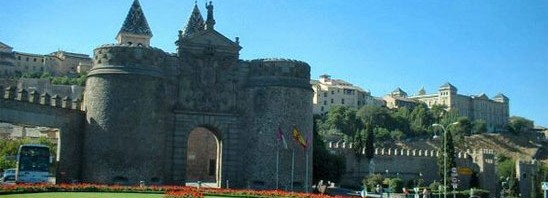
Toledo, just an hour away from Madrid and far-famed as the “city of three cultures”, because the Jews, Muslims and Christians lived here together for centuries, received its World Heritage City distinction in 1986. When you visit this splendid city, a labyrinth of shared history and living, discover some of the best preserved cultural and artistic legacy present behind the city walls in the form of palaces, mosques, synagogues, churches and fortresses.
As you enter the city, behold the city gate - the Puerta de Bisagra; admire the Bridge of Alcántara and the Bridge of San Martín; marvel at the Alcázar of Toledo Castle, positioned on the highest point of the Old Town; experience peace at the solemn Cathedral; visit the Plaza de Zocodover, the lively square flanked by cafes; and relax in the Cigarrales orchards. Immerse yourself in the beauty of the mosques of Tornerías and Cristo de la Luz, the synagogues of El Tránsito and Santa María la Blanca, the Palace of Fuensalida, the Monastery de San Juan de los Reyes, the Jesuit Church and the Santa Isabel and Santo Domingo convents and numerous other wealth of monuments housed in Toledo.
If you are a history buff and an art lover then do visit the museums such as the Sephardic Museum, the Museum of Victorio Macho, the Museo de los Concilios Visigodos and the Museum of Santa Cruz, which generally houses visiting exhibitions. Don’t forget to visit the Museum of El Greco and discover some of the most significant work by the Cretan artist, El Greco.
The best time to visit the city is during the Easter celebrations that peak on April 9-10, when hooded figures walk the streets; or during the Corpus Christi of Toledo, the procession of the Holy Corpus Christi, a festival declared of International Tourist Interest that occurs from 16-22 June every year.
Cordoba
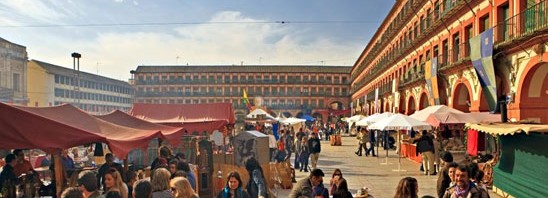
Cordoba, positioned in the interior of Andalusia near the River Guadalquivir, is an ancient city with an impressive monumental and cultural patrimony, which bears testament to the varied cultures that settled here throughout its history. When you travel to this spellbinding city, get mesmerized by the high class heritage in the form of squares, small streets, walls, temples, bridges, convents, stately houses, historic documentation, courtyards, mansions, statutes, traditions, archaeological sites and the famous people.
In Cordoba, the historical past and modernity blend together seamlessly. The city offers all modern infrastructures and amenities and is easily accessible from all the big cities, like Seville and Madrid, thanks to the extensive railway network and the high speed train (AVE). When you step into the city, visit the Cathedral-Mosque of Cordoba, one of the biggest and the oldest mosques in Europe that has been declared as World Heritage Site in 1984; walk around it and discover a stunning network of white-washed courtyards, alleyways and squares that have been declared as World Heritage Site in1994. Behold the Calahorra Tower and the Alcázar fortress of the Christian Monarchs; if you like museums, visit the Archaeological Museum, the Bullfighting Museum, the Julio Romero de Torres Museum and the Fine Arts Museum.
Next, enjoy shows in flamenco clubs located in Jewish Quarter; take a guided night tour; party till late night in fashionable nightspots and discotheques in areas such as Ciudad Jardín, El Arenal or Polígono Chinales; or relax in the leisure centers with multiplex cinemas, restaurants and shops like Guadalquivir Cinemas Cines, Zoco Multicines and El Arcángel.
The best time to visit the city is from the months of May till October, when a lot of local fairs and festivities are held in the city. Some popular leisure events included in Cordoba's calendar are the annual “Festival of the Patios (Courtyards)” that has been added to the list of Intangible Cultural Heritage of Humanity sites by UNESCO in 2012; the "Pop-Zoblanco", a summer event for upcoming young rock and pop artists; the flamenco and horse shows called the Nights of Enchantment "Noches de embrujo", organized in July and August; the Audiovisual Creation Competition of Cabra that is about short films; the annually held festival in Palma del Río called the “Theatre Fair of the South”; and the festival of “Sensxperiment” that focuses on the latest trends in experimental art and multimedia.
Avila
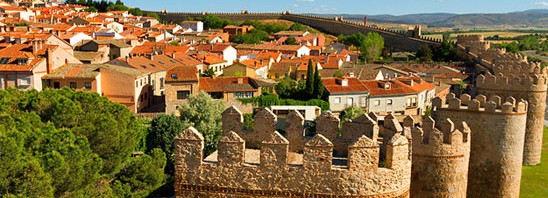
Avila, surrounded by the Sierra Gredos Mountains, is Spain’s highest provincial capital that received its World Heritage City distinction in 1985. This contemporary city that combines history with modernity, being Saint Teresa’s birthplace, has numerous valuable set of religious buildings and churches linked to the saint's life, along with a number of Renaissance palaces that testify for the past wealth of the city as a textile center.
A trip to this magnificent city, just an hour outside of Madrid, would certainly leave you wanting more. Historical houses, walls, palaces, convents, churches, art, traditions, gastronomy, music and nature, all make up the Avila’s artistic heritage.
When here, stroll along the spectacular city wall; marvel at the Convento de Santa Teresa; explore the various turrets and archways that formerly protected the city; gawk at the Gothic cathedral that resembles a fortress; visit the Romanesque churches of San Pedro, San Segundo and San Vincente; and do savor the egg yolk candies known as yemas de Santa Teresa.
The best time to travel to the city is when Easter celebrations and a lot of religious festivals occur that feature street processions and lively carnivals. Some popular Annual Avila Festivals are the Holy Week (La Semana Santa) held in March; Outdoor Festival held in July; Pilgrimage of Our Lady of Chilla held in September; and “The Fiesta de Santa Teresa”, held in October to honor the saint with 10 days of concerts, processions and fireworks.
Salamanca
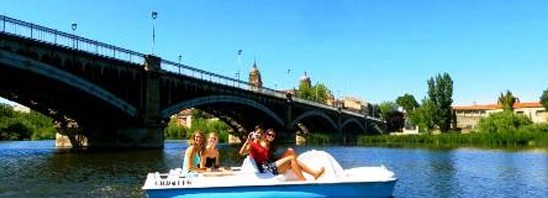
Salamanca, a fine Renaissance city located in the central part of Spain with its rich historic-artistic heritage, majestic convents, magnificent palaces, squares and mansions, received its World Heritage City distinction in 1988. This inland destination is worth discovering for numerous reasons, one being, admiring the golden hue of the city at dusk, owed to the sunlight that falls on the buildings built from old yellow sandstone ‘Villamayor’, earning it the name, ‘the Golden City’.
Travelling to this exquisite city from the main Spanish cities like Madrid (being just around 212 kilometers away from it) is easy by means of extensive transport network. When here, feel the liveliness of the city and its contemporary and cosmopolitan air amidst its brilliant history, because of thousands of students studying at the sprawling University, one of the oldest universities in Europe.
Behold the vast, arcaded, harmonious Plaza Mayor designed by Alberto Churriguera in the 18th century; discover the two great cathedrals, Nueva and Vieja, placed side by side; visit the exquisite House of Shells that has elements of Mudéjar, Gothic and Renaissance; visit the cafés and shops located in the arches; see the medallions of famous figures such as Franco and Miguel de Umanumo; marvel at the Casa de las Muertes that displays the filigree plateresque decoration; witness the dun-colored walls and domed cathedrals; walk Salamanca's streets and experience the layers of Islamic, Visigothic, Roman cultures, which influenced the city for centuries; or enjoy performances by bunches of costumed dancers with their snapping castanets spilling out from local restaurants.
The best time to travel to the city is in the second week of September when the Virgen de la Vega festival occurs.
Alcalá de Henares
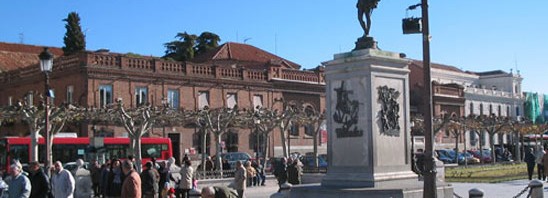
Alcalá de Henares, birthplace of the world-renowned Miguel de Cervantes, author of “Don Quixote”, received its World Heritage Site distinction by UNESCO in 1998. The city’s epic heritage, shaped by university buildings, convents, palaces, gardens, mansions, monasteries and churches, imparts a glimpse into the life during the Spanish Golden Age.
Situated just about 30 kilometers northeast of Madrid and located on the banks of the River Henares, Alcalá de Henares is easily accessible via train, bus and airplane. When here, enjoy an unparalleled ensemble of glorious constructions from the baroque and the Renaissance periods; visit the Plaza de Cervantes square and the Old Town, which spreads around it; marvel at the outstanding University building and experience the youthful spirit of the city, thanks to thousands of students that come to study here; stroll down the Calle Mayor street full of nice shops, tapas bars and restaurants; visit the majestic Cathedral and the Archbishop's Palace and stopover at the convents of Madre de Dios and San Bernardo located in its vicinity; explore the Cervantes Theatre, birth house of Cervantes, now a museum that houses a superb collection of Cervantine publications.
Don’t forget to see the main highlights of the city that include popular areas known as the Prado, Reina Sofía and Thyssen museums, the Madrid of Los Borbones and Los Austrias and the typical neighborhoods of Chamberí and Lavapies.
Alcalá de Henares offers festivals and events of interest almost every month of the year. However, the best time to travel to the city is when famous cultural events such as the Festival Short Alcine, the Festival Theatre Classics in Alcalá and the Cervantes Week occur in April during Easter.
Ibiza
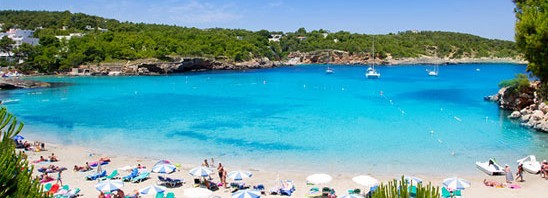
Ibiza, world-renowned as one of Europe’s hippest party destination, is home to over 100 miles of coastline with around 50 beaches that has abundance of clubs, bars, restaurants and water sports, situated mostly on the western coast. On the eastern coast of the Ibiza Island is the relatively undisturbed and unspoilt, Eivissa aka Ibiza Town, one of the most historic cities that received its UNESCO World Heritage Site status in 1999. The real charm of the Eivissa city rests on the rich heritage left by successive civilizations that lived here for centuries of history.
Ibiza is easily reachable via international flights up to Madrid and 1-hr domestic flights from Madrid. Ferries also connect major cities like Barcelona, Dénia, Majorca and Valencia to Ibiza. When here, explore Dalt Vila, the fortified town positioned on the city’s higher part behind a ring of huge Renaissance walls; visit the 13th-century cathedral located on the Dalt Vila pinnacle; explore the labyrinth of winding alleys in the town; enjoy the coves and sands at Talamanca, Figueretes and Es Viver, besides its diverse marine ecosystem.
Behold the gate to the walled area “Portal de ses Taules”; visit the City Hall, the chapel of Sant Salvador and the church of Santo Domingo; explore the Episcopal Palace and its illustrious gateway; marvel at the tallest building in the city “Castell o Almudaina”; discover the priceless collection of Carthaginian and Phoenician artifacts at the Archaeological Museum. Don’t miss out the necropolis of Es Puig des Molins, the Ses Salines Nature Reserve and the Phoenician town of Sa Caleta.
The best time to travel here is from May till October, when popular fairs and festivals occur like the Medieval Fair in May, Patron Saint Day celebrations, the Pages Festival and many more. There is an all together different air to the city during these festivals, ranging from cookery competitions to flower parties, traditional shows & dances to culture days, you will experience everything here.
Cáceres

Cáceres, the capital of the Region of Extremadura, rich in terms of unspoilt nature, historical heritage, wines and gastronomy, is an amalgamation of Northern Gothic, Islamic, Roman and Italian Renaissance styles, which has yielded the city the World Heritage City designation by UNESCO in 1986.
Easily reachable from Seville and Madrid in three to four hours via train and bus, Cáceres is a part of the historical Silver Route (Via de la Plata), a road used by the Romans to travel from Sevilla to Astorga in Castile and León. The city’s ancient walls have kept time outside the city’s boundaries and have preserved the medieval town in its authenticity.
When here, enter the medieval quarter via “El Arco de la Estrella” gate; walk along the labyrinth of cobblestone streets and explore the pretty concentrated historic center; admire the Renaissance palaces and fortified ancestral houses; walk around the Plaza de Santa María square; behold the Carvajal palace and the thousand-year-old fig tree standing in the center of its courtyard; marvel at the 16th century Mayoralgo Palace and the Episcopal Palace; visit the 15th century Gothic Santa María Pro-cathedral; stopover at the exquisitely designed 15th century Golfines de Abajo Palace.
Next, visit the San Mateo square that is home to the House of the Veletas, the House of Lorenzo de Ulloa and the Paredes Saavedra House, all which date from the 15th and 16th centuries; go to the the Cáceres Museum that houses a collection of ethnographic artefacts and archaeological pieces; slip into the San Mateo church; explore the Plaza Mayor, far-famed for its Balbos Forum and numerous towers; be amazed by the Godoy Palace that has a lovely corner balcony. Don’t miss out the Santiago church, the Nuestra Señora de la Montaña Church, the beautiful Guadalupe Monastery and the stunning Monfragüe National Park that has been declared as a Special Bird-Protection Area.
The best time to visit the city is during spring and autumn as Cáceres looks the most stunning during these times. Fairs and festivals occur all year round, so you can enjoy your visit to the city anytime. Some of the famous fairs are Fiesta de los mártires in January; Fiesta de San Blas and Fiesta de las Candelas in February; San Jorge in April, when fireworks take place and a dragon is burnt in the Plaza Mayor on a bonfire; and Ferias de Mayo in May.
Cuenca
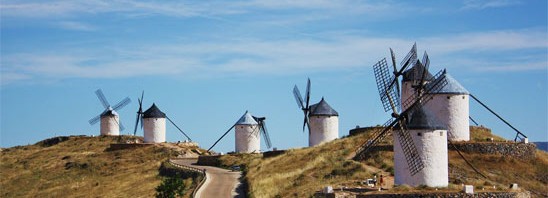
Cuenca, located in the province of Castille-La Mancha, spreading out from atop a promontory in between the Júcar and Huécar river canyons, received its UNESCO World Heritage Site designation in 1999. The picturesque city is a spectacular sight, both stately and medieval, where both modern and cultural heritage complement one another. Cuenca’s history, full of Jewish, Muslim and Christian roots has left an assorted legacy, which increases the drama of the town.
Situated just about 100 kilometers from Madrid, Cuenca is easily reachable in about 45 minutes from there in the high-speed AVE train. When here, get charmed by the wealth of monuments; start with the parish church of Nuestra Señora de la Luz; walk over the San Antón bridge; stop at the San Felipe Neri church, beautifully decorated with Rococo and Baroque motifs; climb to the Plaza de la Torre Mangana, one of the chief symbols of the town; and visit the Science Museum that offers children-friendly interactive exhibitions.
Walk through the Plaza de la Merced and discover fine examples of Baroque in San Julián’s grand seminary and in the convent of La Merced; explore Nuestra Señora de Gracia’s Gothic Cathedral and the Town Hall standing In the Plaza Mayor. Get mesmerized by the far-famed “Casas Colgadas” aka Hanging Houses with wooden balconies, called so because of their perilous placement on the border of a gorge and the Basilica of Our Lady of Grace. Visit the Diocesan Museum, the Provincial Museum and the Bishop's Palace. In Cuenca’s urban setting, discover numerous corners bursting with narrow streets, little arches and charming fountains.
A good time to visit the city is during the Religious Music Week that occurs at Easter and is a festival of International Tourist Interest. Music enthusiasts, performers and scholars arrive at the chosen venues like the Museum of Spanish Abstract Art, the Cuenca Auditorium and the church of San Miguel during this festival.
Santiago de Compostela
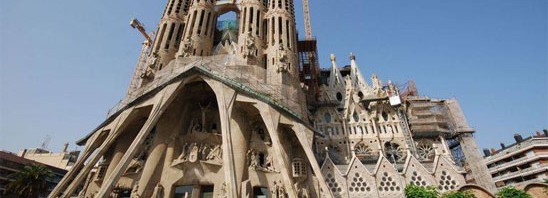
Santiago de Compostela, the capital of the Region of Galicia and home to one of the grandest and the oldest cathedrals in Spain that is the final destination for the people on the Camino de Santiago pilgrimage continuing from the medieval age, received its UNESCO World Heritage Site designation in 1985. Annually millions of pilgrims arrive here by bike, on horseback and on foot to have this experience, a combination of spirituality and adventure.
Santiago de Compostela is a bit far from main Spanish cities like Madrid and Barcelona but can be reached via plane in an hour. When here, saunter through the squares and streets that form an unrivaled, homogeneous and harmonious ensemble; feel the spirit of its people, who receive travelers from all the diverse pilgrimage routes; and experience the vigorous presence of students who study in its 500 year-old University.
When inside the Cathedral, visit the Cathedral rooftop and witness the full splendor of monumentality of Santiago de Compostela. Next, go to the City of Culture of Galicia, a superb and extraordinary building that organizes fascinating cultural activities and temporary exhibitions; walk through the Alameda and San Domingos de Bonaval parks and enjoy the picturesque panoramic view of the massive district; visit the ethnographic museum, Museo do Pobo Galego that has the splendid baroque triple spiral staircase, “Domingo de Andrade”; and stop at the incredibly designed Galician Contemporary Art Centre that houses some amazing artworks.
The best time to visit the city is during the fiestas held in honor of the Apostle Santiago in the month of July that has attained the International Tourist Interest designation. Apart from it, the city organizes impressive program of events all year-round – conferences, film, festivals, art, music, dance, theatre, concerts, games and exhibitions held in various venues that fill the squares and streets on the most important dates.
Merida
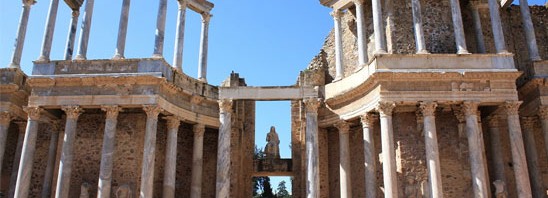
Merida, situated in the path of the Silver Route, heir to the glorious Roman legacy, received its UNESCO World Heritage Site designation in 1993. This ancient capital of Roman Lusitania is home to one of the most well-preserved and the highest number of Roman monuments in Spain.
This archeological ensemble is about 200 kilometers away from Seville and a bit far from Madrid and Barcelona, but it can be accessed easily via car or train. When here, observe the glorious history of Merida in the monumental ensemble preserved here. Visit the Roman Theatre and the Amphitheatre, both emblematic constructions preserving some original elements like the gallery, the box and the grandstands, where classical plays are enacted; walk over the magnificent Puente Romano, one of the longest Roman bridge built over the Guadiana River; behold the grand Arch of Trajan and the Temple of Diana, stroll over the remains of the Circus Maximus; explore over 36,000 artifacts at the National Museum of Roman Art; and make a stop at the Morerias archeological site.
The best time to visit Mérida is in July and August, when the Roman theatre and Amphitheatre host the International Classical Theatre Festival and showcases numerous Greek plays and other performances.
About Odyssey Travels
Odyssey Travels is a leading IATA accredited Travel Company, established in 1992. We specialize in planning customized holidays in India and abroad for our clients which includes air ticketing, worldwide hotel reservations, inclusive tours, sightseeing activities, visa assistance & travel insurance services. For further information or to make a booking contact 020-66442929 or visit http://www.odysseytravels.net/